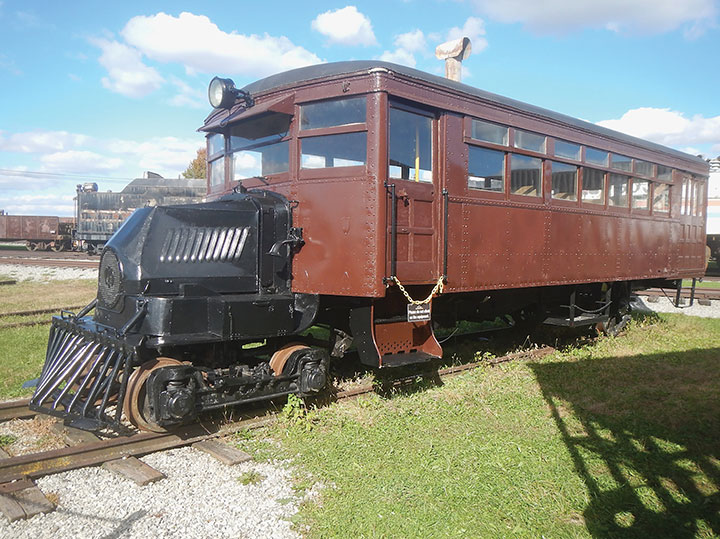I’m 74 years young and I’ve been modeling the Buffalo Creek & Gauley (BC&G) in S scale for four decades. Over the years I’ve shared quite a bit of my BC&G modeling through the pages of Narrow Gauge & Short Line GAZETTE and other modeling publications. I enjoy putting together the stories of how I research and create models of the rolling stock and structures of the BC&G, a fascinating, but rarely modeled West Virginia short line. If nothing else, writing articles for publication is a way to preserve the BC&G story for future modelers.
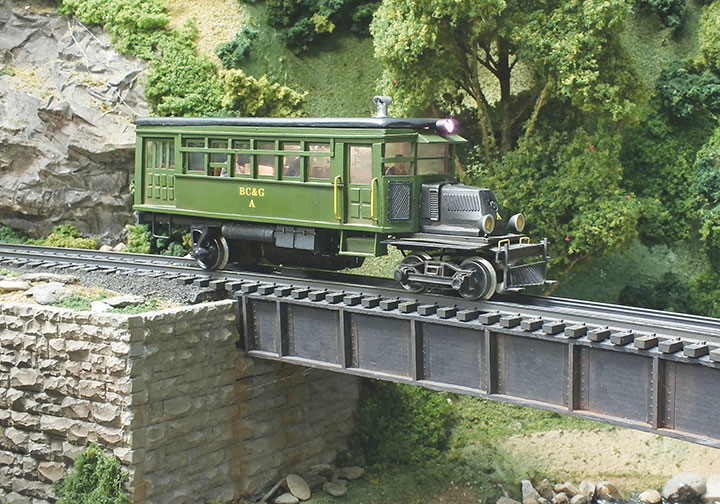
I was recently going through some of my earlier published articles, and I came across the July/August 1995 issue of S Gaugian. S Gaugian, which ceased publication in 2019, was published by Don Heimburger and contained S scale material exclusively. On the cover of that issue was a color photo of my model of BC&G’s Mack railbus, known on the BC&G as Motor A. In looking back over the article, I realized that my model, now itself over 25 years old, has a fascinating history of its own. In this article I tell the story of this little scratchbuilt model and how it evolved, and I describe the prototype that inspired it.
Discovering The BC&G
I began looking for a prototype to model in the early 1980s. I knew I wanted to model something a little different. I also knew I wanted to stay with S scale as I had S toy trains as a kid and liked their size, and the fact that it was a less-modeled scale. It quickly became clear that modeling in S meant I was going to have to scratchbuild a fair amount, a challenge I was willing to accept. All these years later, I’m glad I’ve stayed with S.
When I came across photographs and information about the Buffalo Creek & Gauley, and its sister logging operation, I was hooked. The line had three chunky Consolidations, a couple old coaches and an ex-B&O caboose—perfect subjects for a modest-sized S layout. But the hook was set when I discovered that the BC&G also rostered a Mack AC railbus!
The Prototype
There is a great deal of information about BC&G’s railbus, partly because it still exists, but more about that later. The bus is well documented in The History of Mack Rail Motor Cars and Locomotives published in 1959 by the Lehigh Valley Chapter of the NRHS. The chassis was built by Mack, the truck people, and the body was built by Brill. The bus was constructed as c/n 6005 and became #20 for the Lewisburg, Milton & Watsonville Passenger Railway (LM&WP), a Pennsylvania trolley line that bought the railbus new. In 1928, it became PRR #4738 and in 1931 it was sold to the Artemus-Jellico, a Kentucky short line, before going to the BC&G in 1941.
Mack AC models had a 64 hp, 4-cylinder gasoline engine. As delivered, the ACs had the distinctive bulldog hood used on Mack trucks of the time. Model ACs had 4 forward and 4 reverse gears and were capable of about 30 mph in either direction. Couplers were an option, but Mack discouraged pulling trailers with their busses. The BC&G’s bus did not have couplers on either end. Only 12 Model AC busses were built, of which three went to Cuba.
On The BC&G
On the BC&G, the railbus became known as Motor A. This nomenclature apparently did not have anything to do with its Mack AC designation, but rather stemmed from the fact that the BC&G acquired a second, smaller railbus made by the FWD Company, making the Mack AC the first, hence the ‘A’ designation. The BC&G’s FWD Co. railbus was designated Motor B.
Motor A was used in scheduled pas-senger service on the BC&G for many years. It made two round trips a day along the full 18.6-mile length of the railroad between Dundon and Widen. The bus had a small baggage compartment at the rear, and it stopped regularly at the dairy in Cressmont, about halfway along the line, to pick up bottled milk which was distributed to the several small communities owned by the BC&G’s parent company, the Elk River Coal & Lumber Company. There are photos of the bus at a small, corrugated metal shed at Widen used to store mail, so it is likely that it also served as a mail truck. Besides milk, other light freight was shipped in the baggage compartment. Passenger service ran as late as 1959. After that, the bus was used during the occasional railfan trip.
When it arrived on the BC&G, Motor A had the original Mack engine and bulldog hood and the Mack cowl-mounted radiators. The reconfiguration of the distinctive Mack hood into a decidedly less elegant form was done by the BC&G crews when the original Mack engine was replaced with a “modern” in-line 6-cylinder engine from a Chevrolet pickup truck.
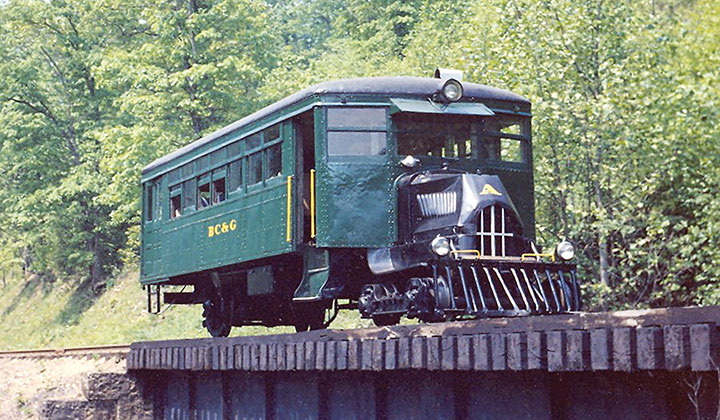
Cody Burdette, a former employee who worked at the company’s sawmill in Swandale, has indicated that the replacement of the Mack gasoline engine was done by Ralph Acree, a long-time welder and mechanic at the railroad’s Dundon engine house. Cody doesn’t know the exact date of the retrofitting, but it was after July of 1948 and before 1950 because it was already done when he was hired onto the railroad in that year. According to Cody, Acree tried to run an auto repair shop out of the old Dundon engine house after the railroad closed, but gave up on it after a short while.
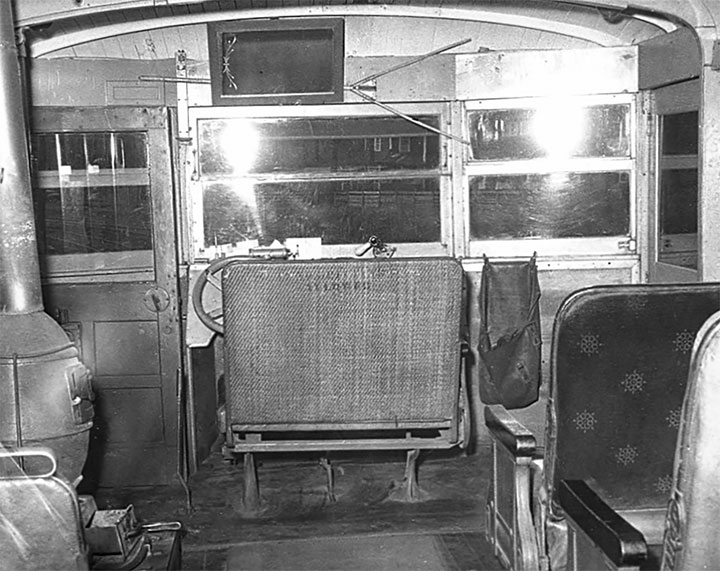
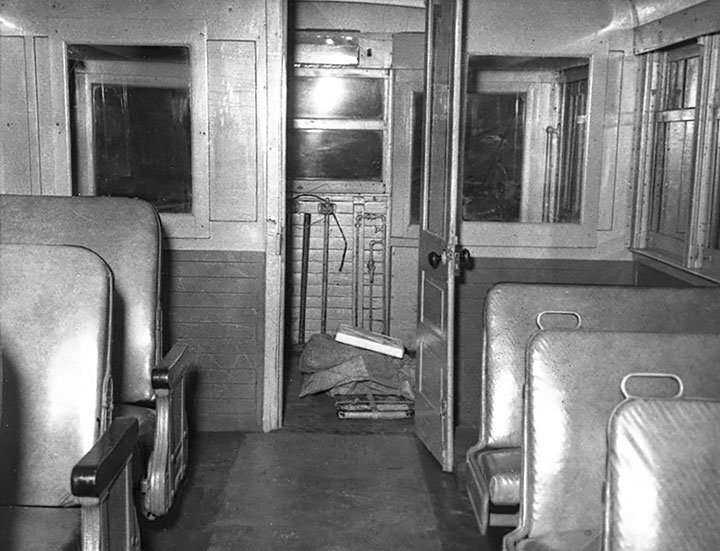
There were other modifications made to Motor A over the years. The cowl-mounted radiators were removed, and a horn was mounted on the left front. Color photos show it was painted in numerous shades of green over the years. Available photos show the lettering on the side simply read “BC&G A.”
Train Robbery Story
There are a number of great stories related to Motor A. As one of them goes, on October 3, 1952, at the height of the labor unrest at the company’s Rich Run Mine in Widen, Motor A was held up at gunpoint by eleven armed men, presumably strike sympathizers. They forcibly removed and robbed the passengers, beating up those that resisted. This unfortunate event is often reported as the last armed train robbery on a common carrier in the U.S. The story, however, is challenged by some sources as either exaggerated or completely bogus. Nonetheless, it adds to the lore of Motor A.
Laid Back Bus Operations
Some have characterized the BC&G as a standard gauge railroad with a narrow gauge character. A good example of the truth of this notion can be found in a story by a fellow model railroader, Dave Marquis, who shared it with me. Dave had the wonderful fortune to ride on Motor A in revenue service on several occasions in 1957 or 1958. One time after buying his ticket at the Company Office in Dundon (from the railroad’s general manager, Richard Manning himself, no less!), he boarded the bus at the road crossing as there was no passenger platform at that time. Dave recounts that “they didn’t actually give me a ticket. I just paid and the railbus driver just trusted that I’d done so.” On one of the trips, Dave was the only passenger.
Dave recounts that on another trip, just as the bus was about to leave Dundon, a pick-up truck pulled up to the crossing with two men and a wringer washer. One of the men had just purchased the used washing machine in nearby Clay, and the previous owner was delivering him and the washer to the BC&G. The two men loaded the washer into the baggage compartment at the rear of the railbus. Off they went with the new owner and Dave as the only passengers. Four or five miles out of Dundon, the bus came to a house along the tracks with no obvious access but by rail. The proud owner of the washing machine and the railbus driver carried the washer up to the front porch, the owner calling out to his wife to show her their new acquisition. Then the two of them sat down and had a cup of coffee and a chat while Dave waited in the railbus! Such was the casual pace of life along the BC&G.
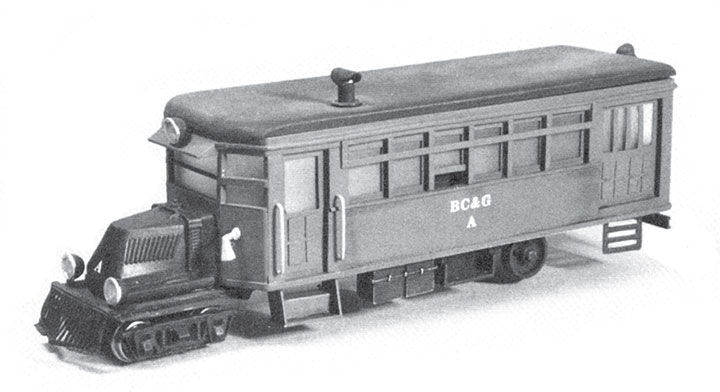
The Model
The model of Motor A was the first piece of motive power I ever attempted to scratchbuild. At the time I started the model, I did not have an accurate dimensioned drawing of the bus and so key dimensions were estimated from photos. My aim was to capture the character of the bus, if not the exact dimensions. The chassis was fabricated from a piece of aluminum plate. When first constructed, the motor and a massive flywheel were inside the body above the floor and connected directly to a NWSL gear box. At that time, my layout used Dynatrol command control, and the associated electronics were mounted inside the body.
The body was built from styrene and the roof was shaped from a piece of balsa. Frosted glass prevented seeing the mechanicals inside. The front truck was created by widening an HO freight car truck with wipers fitted to all four wheels. The rear drive wheels were plastic freight car wheels. A single bulb illuminated the interior but there were no working exterior lights. I chose to model the bus with the original Mack bulldog hood rather than the chopped-up hood created when the Chevy engine was installed. The Mack hood came from a Railmaster Models Mack truck model. Photos show that Motor A never had marker lights while on the BC&G.
Over the years, the model underwent some significant modifications which improved both the appearance and the performance. The changes were dictated each time a new layout was built and the track and/or control system changed. When I built my second layout with DCC and a track system with turnouts fitted with unpowered frogs, more reliable electrical pickup was required. The front truck was replaced with a modified S scale freight car truck and the larger metal wheels were fitted with wipers. The rear drive wheels were also replaced with metal wheels with wipers producing all-wheel pickup. The new rear axle required the installation of non-prototypical outside bearings, a compromise I was willing to make. To make room for a Soundtraxx ‘Goose” decoder, Lenz motor decoder and speakers; the original motor was moved below the floor and replaced with a flat can motor. Hey, a motor swap just like the prototype! Operating directional lights were also installed. The bus remained in this configuration and operated flawlessly for many years. It made two round trips during each of the 50 operating sessions I hosted on the layout and never missed a beat.
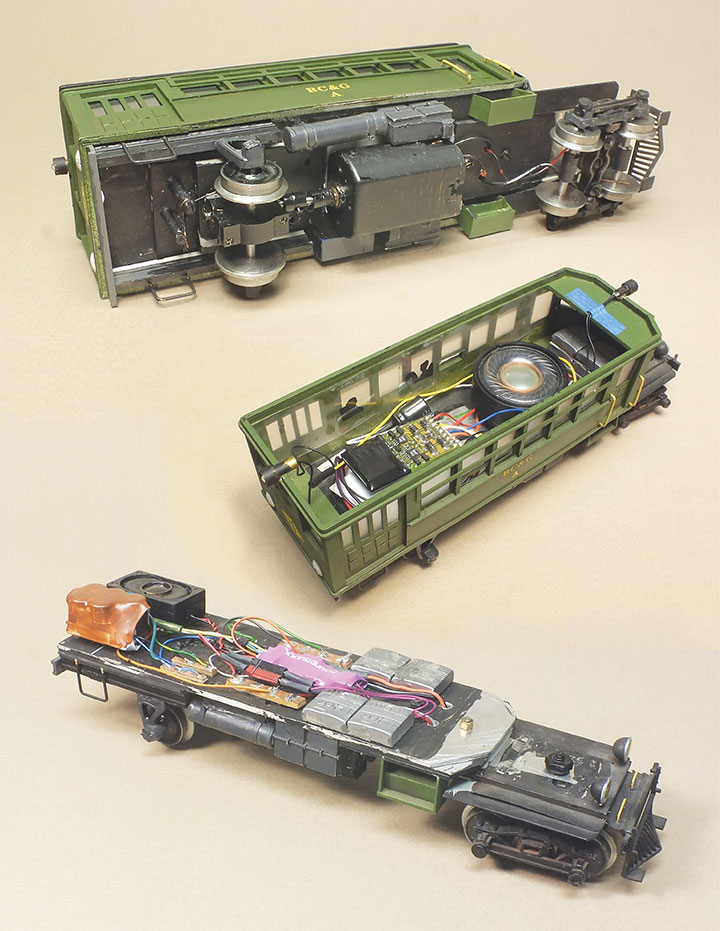
Middle: Moving the motor under the floor freed up the interior space for the Lenz motor decoder, Soundtraxx Goose sound decoder and a large circular speaker. Directional lighting was installed, and passenger silhouettes were put in a couple of the frosted windows. The bus ran for many years in this configuration.
Bottom: The final enhancements included installing a Tsunami2 decoder, current keeper, and compact speaker. The current keeper and speaker are in the baggage compartment, the former painted to look like a stack of barrels covered with a tarp. The decoder was mounted on the chassis below a false floor.
The most recent upgrades were made with the construction of yet another layout and another change of track systems. The new turnouts have even bigger unpowered frogs, and it became necessary to install a current keeper. I used the opportunity to install a new Tsunami2 decoder with current keeper, and while I was at it, decided to install an interior. The decoder was positioned under a false floor and the speaker and current keeper were installed in the baggage compartment with the current keeper painted to look like a tarp-covered pile of barrels. Seats, a pot-bellied stove, a few passengers, and a driver were installed. The frosted window glazing was replaced with clear, and a brighter interior light was installed.
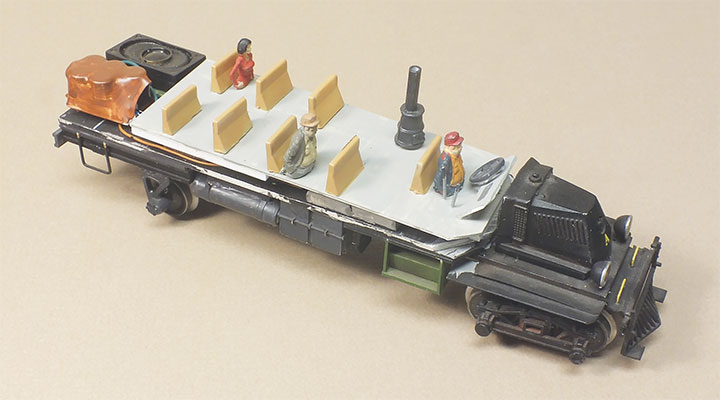
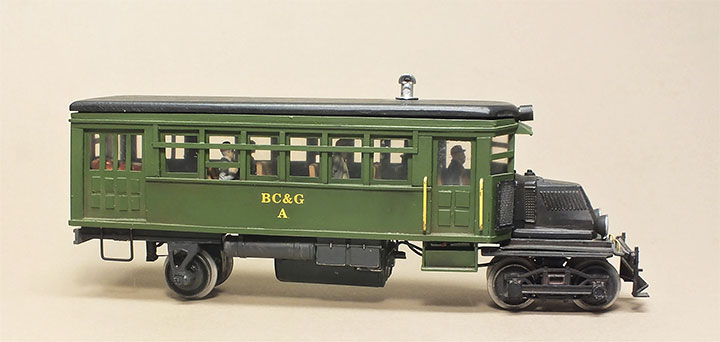
Today And Tomorrow
After all these years, my model of Motor A is in the best shape it’s ever been in, running and looking great. It’s been fun to have this model operating on my layout for as many years as the prototype ran on the BC&G. It’s always been a favorite for operators and non-railroading visitors are surprised that there was a vehicle that looked like a green school bus on the BC&G. I have no immediate plans for any further changes, although at one time I considered adding rivets to the body sides. I have decided to do that only if at some point the body needs repair and repainting.
Fortunately, the real Motor A has also survived and has a bright future. The railbus is owned by the Railroad Museum of Pennsylvania and is currently undergoing a cosmetic restoration and a mechanical restoration is being considered. Fortunately, the hood has been restored back to its original Mack bulldog configuration. In the fall of 2021, the bus received a fresh coat of burgundy paint, the correct color for its original owners, the Lewisburg, Milton & Watsonville Passenger Railway, for whom it will be relettered in the future.
